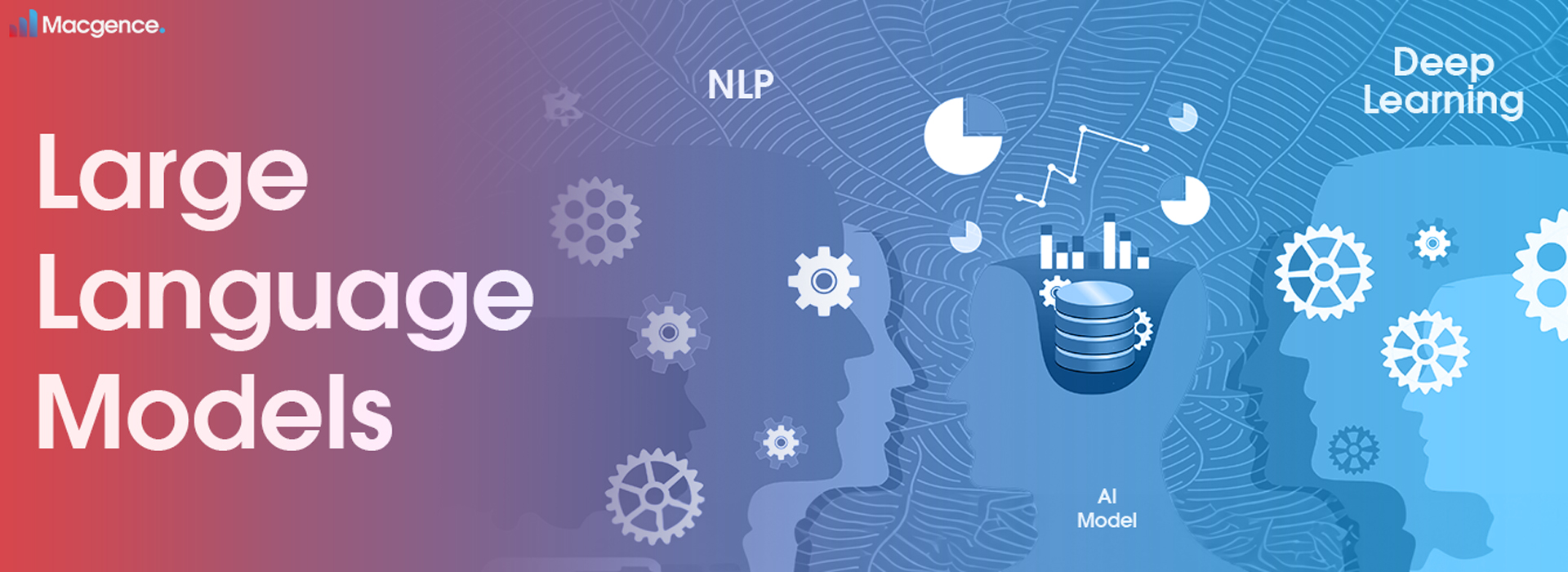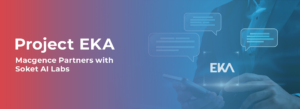- Table of Contents
- What are Large Language Models?
- What is a Transformer in Large Language Models?
- Difference between Large Language Models and Generative AI
- How Large Language Models are Trained
- Benefits of Large Language Models
- Conclusion
- Get Started with Macgence
- Frequently Asked Questions (FAQ’s)
A Simple Guide to Large Language Models for 2023
Artificial intelligence is the word of the season as every organization worldwide is grabbing a piece for themselves. But for each piece of AI to function properly, they need to understand how humans talk. This is where Large Language Models, or LLMs for short, come in.
Now, you may be thinking, what are LLMs? Consider it the component that helps Alexa or Google understand when you ask them something. They have been making our daily lives easier, and it’s time to put LLMs in the spotlight.
This blog will introduce you to the capabilities of Large Language Models, and we will keep it as simple as possible. So, without wasting any more time, let’s dive straight in.
Table of Contents
What are Large Language Models?

Large Language Models are a combination of two main parts of artificial intelligence, which are Natural Language Processing and Deep Learning. They are designed to recognize, understand, interpret, and create human-like texts.
Like every other AI model out there, LLMs are trained on volumes of datasets. These datasets consist of multiple languages, books, blog pages, articles, and website pages—helping them understand the complexities of each language.
We believe most people have heard about the famous Chat-GPT and somewhat about how it works. Well, the OpenAI software is an example of a Large language model; if you have used it, you will know how amazing a tool it is.
However, before moving on, it’s impossible to talk about LLMs without the term “Transformer.”
What is a Transformer in Large Language Models?

Unlike The Transformers franchise, this one is unique. These transformers are a type of neural network that helps large language models easily accomplish difficult tasks.
Additionally, they consist of two parts— an encoder and a decoder. Both parts allow the transformer to analyze a whole dataset or break it into smaller parts to detect patterns and produce results.
Difference between Large Language Models and Generative AI

As mentioned above, the famous Chat-GPT is a good example of a Large language model, but it is also an example of generative AI. So, which is it?
Well, there is no need for you to confuse yourself any further. Chat-GPT is both a generative AI and a large language model. The only significant difference is that generative AI is like the parent of LLMs.
So, if we go by this, all large language models are generative AIs.
How Large Language Models are Trained

For starters, we know these models are trained on massive datasets and must be inputted for the LLMs to work. But this process consists of a series of steps.
Step 1: Data Collection:
Knowing the type of data to gather and where to source them is very important in training LLMs. Because large language models aim to produce texts similar to that of humans. So to know how we humans write, data can be sourced from websites, articles, and books to train large language models.
Step 2: Data Cleaning:
After collecting data, it must be filtered to become a proper training dataset. This involves removing unwanted pieces of information, such as characters, incomplete sentences, etc. Furthermore, these datasets can be broken into smaller chunks called tokens and converted into a format the model can work with.
Step 3: Structure Creation:
This is the process where the structure, also known as the architecture of the LLM, is created. We mean that the type of neural network is selected, the deep learning algorithm to be used is decided, and other computational factors are finalized at this stage.
Step 4: Training the Model:
At this point, the method of training and the actual training of the LLM is carried out. By method, we mean either using supervised or unsupervised learning. LLMs are trained using supervised learning because they need to know what to look out for. But this doesn’t mean large language models can’t be trained using unsupervised learning—they can. If you’re unsure about the meaning of supervised and unsupervised learning, you can check them out in our recent blog, “Beginners Guide on Machine Learning.”
Step 5 : Evaluation:
After training LLM, it undergoes a series of tests and evaluations to see if it is ready to be used in real-world situations. Here, the results produced from a large language model are cross-examined with real-world facts, which will determine whether it needs more fine-tuning or if it’s ready to be deployed.
Step 6: Model Deployment:
After the testing and evaluation stage, the LLM is finally ready to be used. This is where it is integrated into different applications and fields.
Step 7: Model Upgrading:
This is the final stage of training large language models. So, after deployment, there is still room to upgrade the model, especially if the LLM is receiving negative feedback.
Benefits of Large Language Models

The applications of large language models are numerous; for example, virtual assistant chatbots, GPT-3 model, Google BardAI, etc. Let’s highlight some key benefits of LLMs.
- Increased Productivity: With its wide application across various sectors, LLMs are known for increasing the productivity and efficiency of their users. By accurately understanding what is inputted and giving out the right results in a few minutes, makes them reliable.
- Ability to keep evolving: This is the reason why LLMs are so popular at the moment. Since the world runs on data and machine learning is also improving, large language models will always update their current information to recent ones. And by doing this, their accuracy level will also increase.
- Wide range of Applications: As mentioned earlier, LLMs are used almost everywhere worldwide. They help in language translation, writing codes, blogs, and articles. Furthermore, they also help give insights into business data with their ability to process vast datasets.
Conclusion

Large Language Models(LLMs) perfectly blend deep learning and natural language processing. With the breakthrough of Open AI’s Chat-GPT, the world has seen what LLMs can do and expects the next thing. Well, we can say without a doubt that large language models will continue to evolve closer to human natural languages.
Get Started with Macgence
Get started with Macgence, your ultimate destination for your Large Language Model solutions. Our services encompass training your LLM catering to all your machine learning and AI endeavors. With Macgence, you’re assured of scalability, allowing us to handle projects of any size and ensuring on-time delivery. We take pride in providing superior quality, as our skilled staff meticulously cleans, labels, trains, and tests your data to optimize your large language model performance. Our commitment to zero internal bias ensures fairness and neutrality in all processes, enhancing your AI systems’ integrity. Regardless of your industry, Macgence’s cross-industry compatibility ensures customized solutions tailored to your specific needs. Start today and experience the power of LLMs at Macgence.
Frequently Asked Questions (FAQ’s)
Q1. What is the full meaning of LLMs?
Q2. What are Large Language Models?
Q3. Is there a difference between Generative AI and LLMs?
You Might Like
February 28, 2025
Project EKA – Driving the Future of AI in India
Spread the loveArtificial Intelligence (AI) has long been heralded as the driving force behind global technological revolutions. But what happens when AI isn’t tailored to the needs of its diverse users? Project EKA is answering that question in India. This groundbreaking initiative aims to redefine the AI landscape, bridging the gap between India’s cultural, linguistic, […]
March 7, 2025
What is Data Annotation? And How Can It Help Build Better AI?
Spread the loveIntroduction In the world of digitalised artificial intelligence (AI) and machine learning (ML), data is the core base of innovation. However, raw data alone is not sufficient to train accurate AI models. That’s why data annotation comes forward to resolve this. It is a fundamental process that helps machines to understand and interpret […]
March 6, 2025
Vertical AI Agents: Redefining Business Efficiency and Innovation
Spread the loveThe pace of industry activity is being altered by the evolution of AI technology. Its most recent advancement represents yet another level in Vertical AI systems. This is a cross discipline form of AI strategy that aims to improve automation in decision making and task optimization by heuristically solving all encompassing problems within […]
March 5, 2025
Use of Insurance Data Annotation Services for AI/ML Models
Spread the loveThe integration of artificial intelligence (AI) and machine learning (ML) is rapidly transforming the insurance industry. In order to build reliable AI/ML models, however, thorough data annotation is necessary. Insurance data annotation is a key step in enabling automated systems to read complex insurance documents, identify fraud, and optimize claim processing. If you […]


 Previous Blog
Previous Blog







